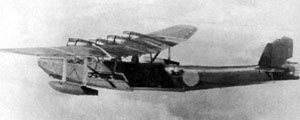Kawanishi H6K
|
|
| Kawanishi H6K4 | ||
|---|---|---|

| ||
| Description | ||
| Role | Patrol flying boat | |
| Crew | 9 | |
| First Flight | July 14 1936 | |
| Entered Service | January 1938 | |
| Manufacturer | Kawanishi | |
| Dimensions | ||
| Length | 25.63 m | 84 ft 3 in |
| Wingspan | 40.00 m | 131 ft 2 in |
| Height | 6.27 m | 20 ft 6 in |
| Wing area | 170 m² | 1,830 ft² |
| Weights | ||
| Empty | 11,707 kg | 25,755 lb |
| Loaded | 17,000 kg | 37,400 lb |
| Maximum takeoff | 21,500 kg | 47,300 lb |
| Powerplant | ||
| Engines | 4x Mitsubishi Kinsei 43 or 46 | |
| Power | 2,984 kW | 4,000 hp |
| Performance | ||
| Maximum speed | 331 km/h | 207 mph |
| Combat Range | 4,650 km | 2,906 miles |
| Ferry Range | 6,580 km | 4,112 miles |
| Service ceiling | 9,610 m | 31,520 ft |
| Rate of climb | 370 m/min | 1,213 ft/min |
| Wing loading | 100 kg/m² | 20 lb/ft² |
| Power/Mass | 0.17 kW/kg | 0.11 hp/lb |
| Avionics | ||
| Armament | ||
| Guns | 1x 7.7 mm Type 97 machine gun in bow 1x Type 97 machine gun in spine 2x Type 97 machine guns in waist blisters 1x 20 mm Type 99 cannon in tail turret | |
| Stores | 2x 800 kg (1,760 lb) torpedoes or 1,000 kg (2,200 lb) of bombs | |
The Kawanishi H6K was an Imperial Japanese Navy flying boat used during World War II for maritime patrol duties. The Allied reporting name for the type was "Mavis"; the Navy designation was "Type 97 Large Flying Boat" (九七式大型飛行艇).
The aircraft was designed in response to a Navy requirement of 1933 and incorporated knowledge gleaned by a Kawanishi team that had visited the Short Brothers factory in the UK, at that time one of the world's leading producers of flying boats. The Type S, as Kawanishi called it, was a large, four-engined monoplane with twin tails, and a hull suspended beneath the parasol wing by a network of struts. Three prototypes were constructed, each one making gradual refinements to the machine's handling both in the water and in the air, and finally fitting more powerful engines. The first of these flew on July 14 1936 and was originally designated Navy Type 97 Flying Boat, later H6K. Eventually, 217 would be built.
H6Ks were deployed from 1938 onwards, first seeing service in the Sino-Japanese War and in widespread use by the time full-scale war erupted in the Pacific. It had excellent endurance, able to undertake 24-hour patrols, and was even used for long-range raids on Rabaul and the Dutch East Indies
The aircraft became quickly vulnerable to the new generation of fighters then appearing, but continued in service throughout the war in areas where the risk of interception was low. In front-line service, it was replaced by the Kawanishi H8K.
Some may have continued to fly in Indonesia in post-war years, but none are extant today.
| Related content | |
|---|---|
| Similar Aircraft | Dornier Do 24 - PBY Catalina |
| Designation Series | H3K - H4H - H5Y - H6K - H7Y - H8K - H9A |
| Related Lists | List of military aircraft of Japan - List of flying boats |
|
Lists of Aircraft | Aircraft manufacturers | Aircraft engines | Aircraft engine manufacturers Airports | Airlines | Air forces | Aircraft weapons | Missiles | Timeline of aviation |
